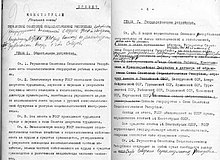Ukrainian Soviet Socialist Republic
The Ukrainian Soviet Socialist Republic (Ukrainian: Українська Радянська Соціалістична Республіка, romanized: Ukrainska Radianska Sotsialistychna Respublika;[note 1] Russian: Украинская Советская Социалистическая Республика[note 2]), abbreviated as the Ukrainian SSR, UkSSR, and also known as Soviet Ukraine or just Ukraine,[11][12][13] was one of the constituent republics of the Soviet Union from 1922 until 1991.[14] Under the Soviet one-party model, the Ukrainian SSR was governed by the Communist Party of the Soviet Union through its republican branch, the Communist Party of Ukraine.
Not to be confused with the Ukrainian People's Republic of Soviets and Ukrainian Soviet Republic that existed in 1917–18 within Russia.
Satellite state of the Russian SFSR (1919–1922)
Union Republic of the Soviet Union (1922–1991)
Kiev
State atheism (treated officially until glasnost era)
Russian Orthodox Church (de facto) (through Ukrainian Exarchate)
Greek Catholic Church (illegal)
Sunni Islam
Judaism
1919–1990:
Unitary Marxist–Leninist one-party Soviet socialist republic
1990–1991:
Unitary multi-party parliamentary republic
Congress of Soviets (1919–1938)[9]
Supreme Soviet (1938–1991)[10]
10 March 1919
30 December 1922
15 November 1939
2 August 1940
24 October 1945
19 February 1954
16 July 1990
24 August 1991
1 December 1991
10 December 1991
26 December 1991
28 June 1996
603,700 km2 (233,100 sq mi)
51,706,746
0.725
high
Soviet ruble (руб) (SUR)
+7 03/04/05/06
The first iterations of the Ukrainian SSR were established during the Russian Revolution, particularly after the Bolshevik Revolution. The outbreak of the Ukrainian–Soviet War in the former Russian Empire saw the Bolsheviks defeat the independent Ukrainian People's Republic, during the conflict against which they founded the Ukrainian People's Republic of Soviets, which was governed by the Russian Soviet Federative Socialist Republic (RSFSR), in December 1917; it was later succeeded by the Ukrainian Soviet Republic in 1918.[15] Simultaneously with the Russian Civil War, the Ukrainian War of Independence was being fought among the different Ukrainian republics founded by Ukrainian nationalists, Ukrainian anarchists, and Ukrainian separatists – primarily against Soviet Russia and the Ukrainian SSR, with either help or opposition from neighbouring states.[16] In 1922, it was one of four Soviet republics (with the Russian SFSR, the Byelorussian SSR, and the Transcaucasian SFSR) that signed the Treaty on the Creation of the Soviet Union. As a Soviet quasi-state, the Ukrainian SSR became a founding member of the United Nations in 1945[17] alongside the Byelorussian SSR, in spite of the fact that they were also legally represented by the Soviet Union in foreign affairs. Upon the dissolution of the Soviet Union in 1991, the Ukrainian SSR emerged as the present-day independent state of Ukraine, although the modified Soviet-era constitution remained in use until the adoption of the modern Ukrainian constitution in June 1996.[18]
Throughout its 72-year history, the republic's borders changed many times, with a general trend toward acquiring lands with ethnic Ukrainian population majority, and losing lands with other ethnic majorities. A significant portion of what is now western Ukraine was gained via the Soviet-German Molotov–Ribbentrop Pact, with the annexation of Eastern Galicia and Volhynia in 1939, significant portions of Romania in 1940, and Carpathian Ruthenia in Czechoslovakia in 1945. From the 1919 establishment of the Ukrainian SSR until 1934, the city of Kharkov served as its capital; however, the republic's seat of government was subsequently relocated in 1934 to the city of Kiev, the historic Ukrainian capital, and remained at Kiev for the remainder of its existence.
Geographically, the Ukrainian SSR was situated in Eastern Europe, to the north of the Black Sea, and was bordered by the Soviet republics of Moldavia (since 1940), Byelorussia, and Russia, and the countries of Romania, Hungary, Czechoslovakia, and Poland. The republic's border with Czechoslovakia formed the Soviet Union's westernmost border point. According to the 1989 Soviet census, the republic of Ukraine had a population of 51,706,746 (second after Russia).[19][20]




